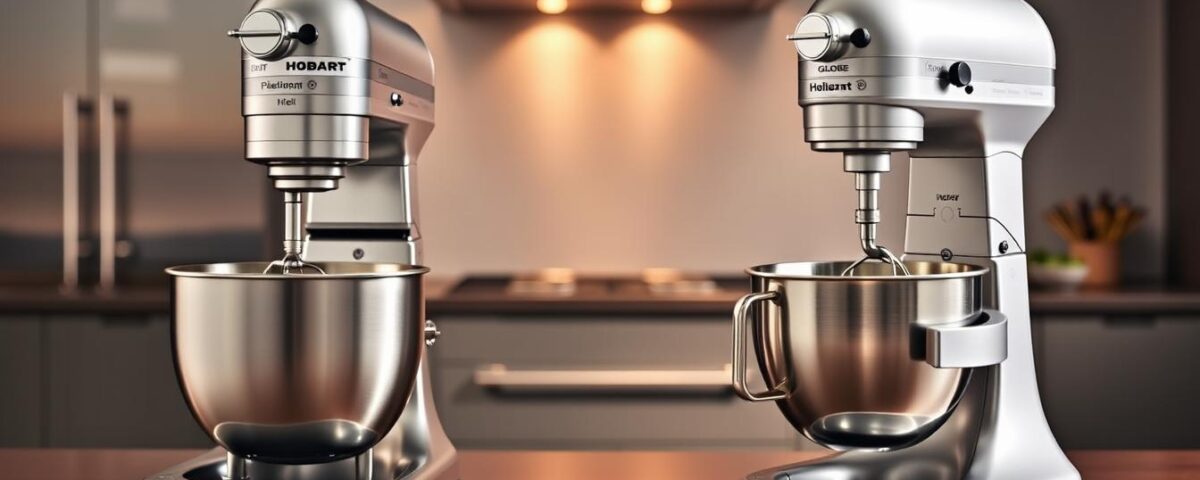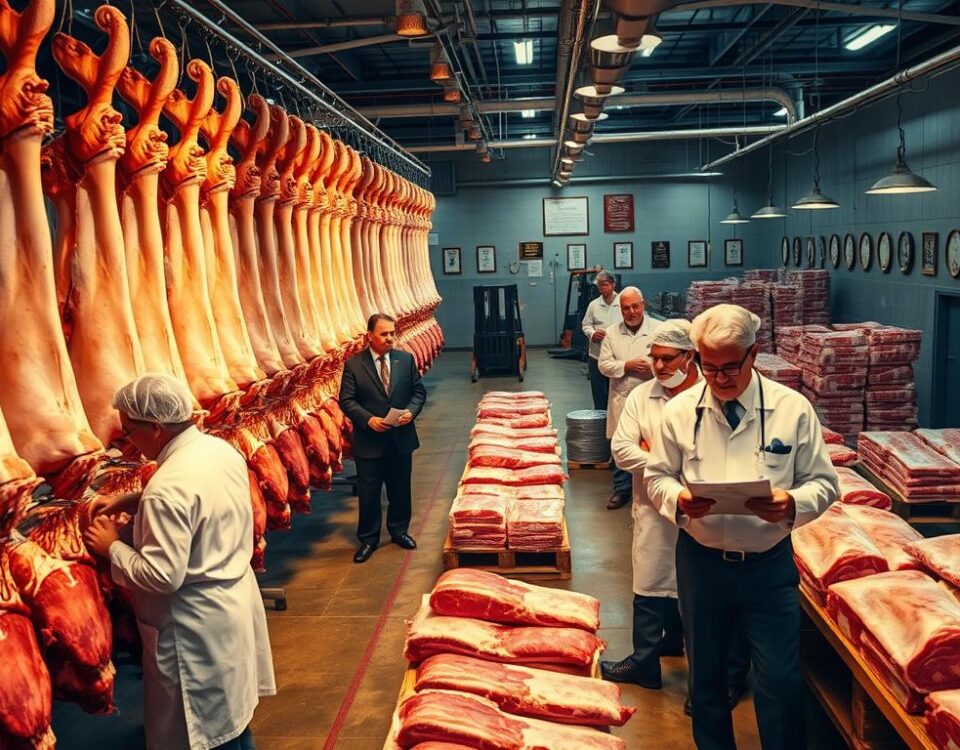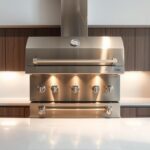
Gas vs Electric Grill: Which Cuts Operating Costs?
September 4, 2025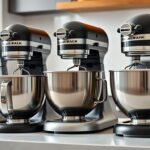
After Testing 5 Heavy-Duty Dough Mixers, This One Surprised Me
September 5, 2025Choosing the right commercial mixer can be a game-changer for any foodservice operation. I recall a busy bakery that struggled with inconsistent dough quality until they upgraded to a high-performance mixer. Suddenly, their production efficiency soared, and customer satisfaction improved dramatically.
Did you know that a reliable commercial mixer can reduce mixing time by up to 50%? With the average kitchen relying on this crucial equipment, selecting the right brand is vital. As you weigh your options between Hobart and Globe, what factors should you consider to make an informed decision?
Key Takeaways
- Understand the key differences between Hobart and Globe commercial mixers.
- Learn how these brands compare in terms of performance, durability, and value.
- Discover the factors that should influence your purchasing decision.
- Explore the unique strengths of each brand and their ideal applications.
- Gain insights into why both brands are highly regarded in the industry.
Understanding Commercial Mixer Brands
Choosing the right commercial mixer is crucial for any kitchen, and understanding the brands behind them is the first step. The commercial mixer market is dominated by a few key players, with Hobart and Globe being prominent names.
The Legacy of Hobart Mixers
Hobart has been a leading name in commercial mixers for over a century, having introduced their groundbreaking Model A-80 in 1914. This legacy has contributed to their mixers being renowned for durability and long-lasting performance, with many units still operational after 30, 40, or more years. Hobart’s commitment to quality has earned them a loyal customer base.
Globe Food Equipment’s Market Position
Globe Food Equipment has been manufacturing high-quality commercial kitchen equipment since the early 1920s, establishing themselves as a trusted competitor in the commercial mixer market. Their focus on durability and reliability, coupled with comprehensive warranty coverage, has positioned them as a viable alternative to Hobart.
“A good mixer is an investment, not an expense. It’s about finding a brand that stands behind its product.”
Why Brand Matters in Commercial Mixers
The brand of your commercial mixer matters significantly, particularly when it comes to long-term reliability and service support. Both Hobart and Globe have evolved their product lines over the years to meet changing kitchen needs while maintaining their core quality standards. A brand’s experience in the industry translates to better-engineered products that can withstand the demands of a commercial kitchen.
| Brand | Years of Experience | Notable Features |
|---|---|---|
| Hobart | Over 100 years | Durable, long-lasting mixers |
| Globe | Nearly 100 years | Reliable, comprehensive warranty |
Understanding the strengths of each brand can help you make an informed decision when choosing a commercial mixer for your kitchen.
Types of Commercial Mixers
When it comes to commercial mixers, understanding the different types is crucial for selecting the right equipment for your kitchen. Commercial mixers are not one-size-fits-all appliances; they come in various designs to handle different mixing tasks efficiently.
Planetary Mixers: The Versatile Workhorses
Planetary mixers are renowned for their versatility and are considered the workhorses of commercial kitchens. They feature an agitator that spins in a planetary motion within a fixed bowl, ensuring thorough mixing of ingredients. These mixers are equipped with interchangeable attachments such as beaters, dough hooks, and wire whisks, making them suitable for a wide range of tasks, from whipping light batters to kneading medium-density dough.
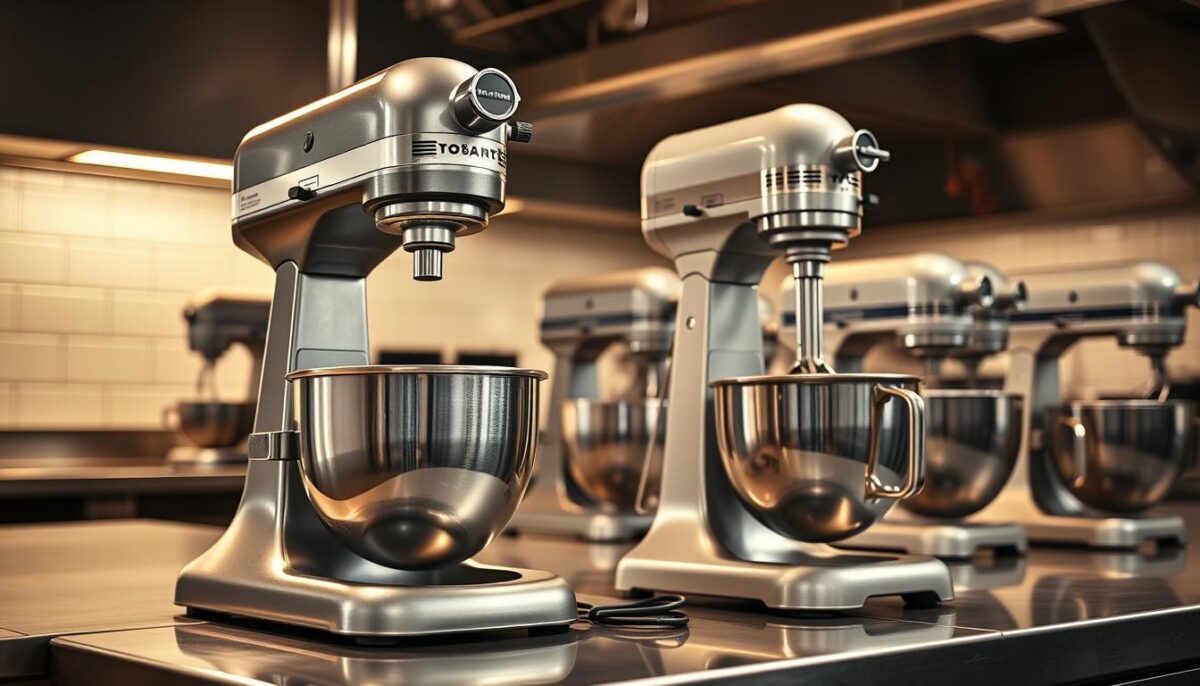
Spiral Mixers: Dough Specialists
Spiral mixers are specifically designed for kneading dough and are ideal for bakeries and pizzerias. They feature a rotating bowl and a fixed spiral-shaped agitator, which gently folds large volumes of dough while maintaining its quality. This design minimizes friction heat, ensuring that the dough is kneaded efficiently without compromising its texture.
Specialty Mixers and Attachments
Both Hobart and Globe offer specialty mixers and a range of attachments that can enhance the functionality of their mixers. These include dough hooks, flat beaters, wire whisks, and other specialty tools designed to handle specific mixing tasks. The right mixer type and attachments depend on your primary application, whether you need versatility for various tasks or specialized performance for dough production.
| Mixer Type | Primary Use | Key Features |
|---|---|---|
| Planetary Mixers | Versatile mixing tasks | Interchangeable attachments, planetary motion |
| Spiral Mixers | Dough kneading | Rotating bowl, spiral agitator |
| Specialty Mixers | Specific mixing tasks | Specialized attachments, customized for tasks |
Hobart vs Globe Mixer: Key Feature Comparison
When choosing between Hobart and Globe commercial mixers, several key features come into play. The right mixer for your commercial kitchen depends on a thorough understanding of these features and how they align with your operational needs.
Motor Power and Performance
The capacity of a mixer is largely determined by its motor power. More powerful motors are used in mixers designed to churn out multiple batches of heavy dough daily. A powerful motor ensures that you can mix close to a full bowl of ingredients in one go without jamming or overheating the mixer. Hobart mixers are known for their robust motors, which provide consistent performance even under heavy loads. In contrast, Globe mixers also offer powerful motors, but the specifications can vary between models.
- Hobart mixers typically offer more powerful motors for heavy-duty applications.
- Globe mixers provide reliable performance, but may require more frequent maintenance.
Bowl Capacity and Design
The bowl capacity and design are critical factors in a commercial mixer’s efficiency. Hobart and Globe mixers offer various bowl sizes to suit different production needs. The shape of the bowl also affects mixing efficiency and ingredient incorporation. Hobart’s bowl design is often praised for its ability to reach all ingredients and prevent unmixed pockets.
Drive Systems and Durability
Commercial mixers utilize three main types of drive systems: belt-drive, gear-drive, and variable-frequency drive (VFD). Belt-drive systems offer more speed choices and allow for on-the-fly speed adjustments. However, they are prone to wear and tear and require more maintenance. Gear-drive systems are more powerful and need less maintenance, but speed changes require turning off the mixer. Some of the latest models feature a variable-frequency drive, offering multiple speed options, on-the-fly adjustments, and high reliability.
- Hobart mixers often employ gear-drive systems for durability.
- Globe mixers may use belt-drive or VFD systems, depending on the model.
Control Options and Precision
The control options available on commercial mixers range from basic manual controls to sophisticated digital interfaces with timers and programmable settings. Hobart mixers are known for their intuitive controls, which provide precise mixing operations. Globe mixers also offer advanced control options, but the user interface may vary between models.
In conclusion, when comparing Hobart and Globe mixers, it’s essential to consider factors such as motor power, bowl capacity, drive systems, and control options. By understanding these key features, you can make an informed decision that meets your commercial kitchen’s specific needs.
Size and Style Options
Size and style are key considerations when deciding on a commercial mixer for your kitchen operations. The choice between Hobart and Globe commercial mixers depends on understanding the various size and style options available to meet your specific needs.
Countertop Models Comparison
Countertop mixers are ideal for low-volume establishments and can easily fit on a countertop or bench. Hobart’s Centerline and Legacy+ countertop models offer a range of capacities, typically up to 10 liters. Globe’s SP series countertop mixers provide similar functionality with varying bowl sizes. When comparing these models, consider their footprint, capacity, and suitability for your kitchen operations.
| Model | Bowl Capacity | Motor Power |
|---|---|---|
| Hobart Centerline | 5-10 liters | 350-500 watts |
| Globe SP Series | 5-10 liters | 350-500 watts |
Floor Models for High-Volume Operations
Floor mixers are designed for heavy-duty use in high-volume commercial kitchens. They offer larger bowl capacities, typically 30 liters or more, and more powerful motors. Both Hobart and Globe offer floor models that are extremely stable and can free up valuable counter space. When selecting a floor model, consider the production volume and available space in your kitchen.
Finding the Right Size for Your Kitchen
To determine the right mixer size for your kitchen, consider your production volume, available space, and typical batch sizes. It’s essential to balance current needs with future growth plans. Matching mixer capacity to your operation’s specific requirements ensures optimal performance and longevity of the equipment.
By comparing the physical dimensions and space requirements of comparable models from Hobart and Globe, you can make an informed decision that fits your kitchen planning needs.
Performance Analysis: Real-World Applications
To determine which commercial mixer is right for you, let’s examine the real-world performance of Hobart and Globe mixers in various applications.
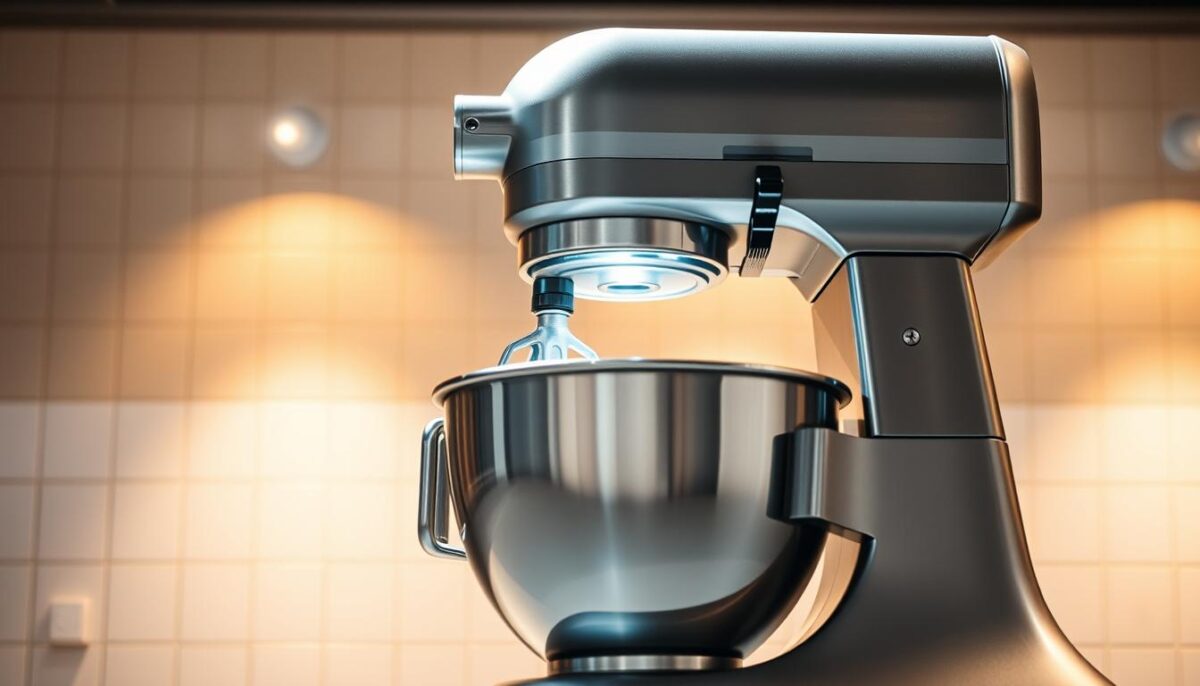
Bakery and Pastry Applications
In bakery and pastry applications, both Hobart and Globe mixers demonstrate exceptional performance. Hobart’s planetary mixers are particularly adept at handling delicate pastry dough, while Globe’s spiral mixers excel at kneading dough for bread and pizza. When it comes to mixing ingredients for cakes and pastries, Hobart’s mixers offer precise control, ensuring consistent results across multiple batches.
Pizza and Bread Dough Performance
For pizza and bread dough, the performance of spiral mixers from both brands is noteworthy. Globe’s spiral mixers are designed to handle high-gluten flour and cold water incorporation with ease, making them ideal for pizzerias. Hobart’s spiral mixers also perform well, gently kneading dough to keep friction heat low, which is crucial for better fermentation. Both brands offer mixers that can handle large batches of bread dough, developing gluten properly without overheating.
General Food Preparation Capabilities
Beyond dough mixing, both Hobart and Globe’s planetary mixers are versatile and capable of handling general food preparation tasks such as whipping, creaming, and blending ingredients. Their performance in these tasks is largely dependent on the quality of the mix ingredients and the specific requirements of the recipe. By offering various speed settings and precision control, these commercial mixers can adapt to different food preparation needs, making them invaluable in commercial kitchens.
In conclusion, both Hobart and Globe commercial mixers deliver strong performance across various applications, from bakery and pastry to pizza and bread dough, and general food preparation tasks. The choice between them will depend on your specific needs and the types of food you prepare.
Cost Considerations: Initial Investment vs. Long-Term Value
To make an informed decision, it’s essential to consider both the upfront cost and the long-term expenses associated with a commercial mixer. This involves evaluating not just the purchase price, but the total cost of ownership over the years you expect the mixer to be part of your operation.
Purchase Price Comparison
The initial purchase price of commercial mixers from high-end brands like Hobart and Globe can vary significantly. For instance, a high-volume (around 60-quart) floor planetary mixer can cost between $24,000 and $35,000. Globe mixers are known for their sturdiness and reliability, but they come with a higher price tag. In contrast, Hobart mixers are renowned for their durability and performance. When comparing models across different sizes and capacities, it’s crucial to consider how the initial price aligns with your budget and operational needs.
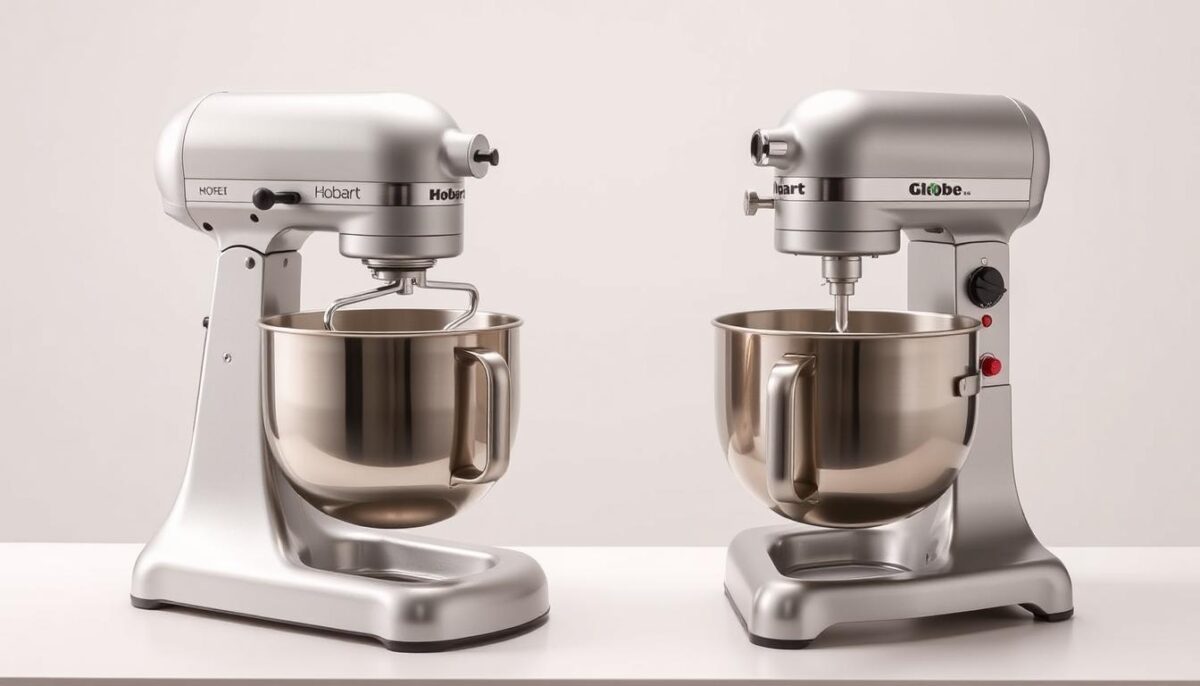
Total Cost of Ownership
Beyond the purchase price, the total cost of ownership includes maintenance requirements, parts replacement, and service costs over the years. A mixer’s design and build quality can significantly impact these costs. For example, a mixer with a robust construction may have a higher upfront cost but could reduce maintenance expenses in the long run. It’s also important to consider the cost of parts and the availability of certified technicians for repairs.
Warranty and Service Support
Both Hobart and Globe offer warranty coverage and service support, but there are differences in their offerings. Globe mixers typically come with a comprehensive warranty that covers parts and labor for an extended period. Understanding the warranty terms, including what’s covered and for how long, is vital. Additionally, the availability of certified service technicians and the distribution network for parts can affect the overall cost of ownership and the mixer’s operational lifespan.
By carefully evaluating the purchase price, total cost of ownership, and the support offered by manufacturers, businesses can make informed decisions that meet their operational needs and budget constraints.
Popular Models Worth Considering
In the realm of commercial baking and food preparation, Hobart and Globe mixers are renowned for their durability and versatility. When choosing a commercial mixer, it’s essential to consider the features and performance of various models.
Hobart Legacy+ Series
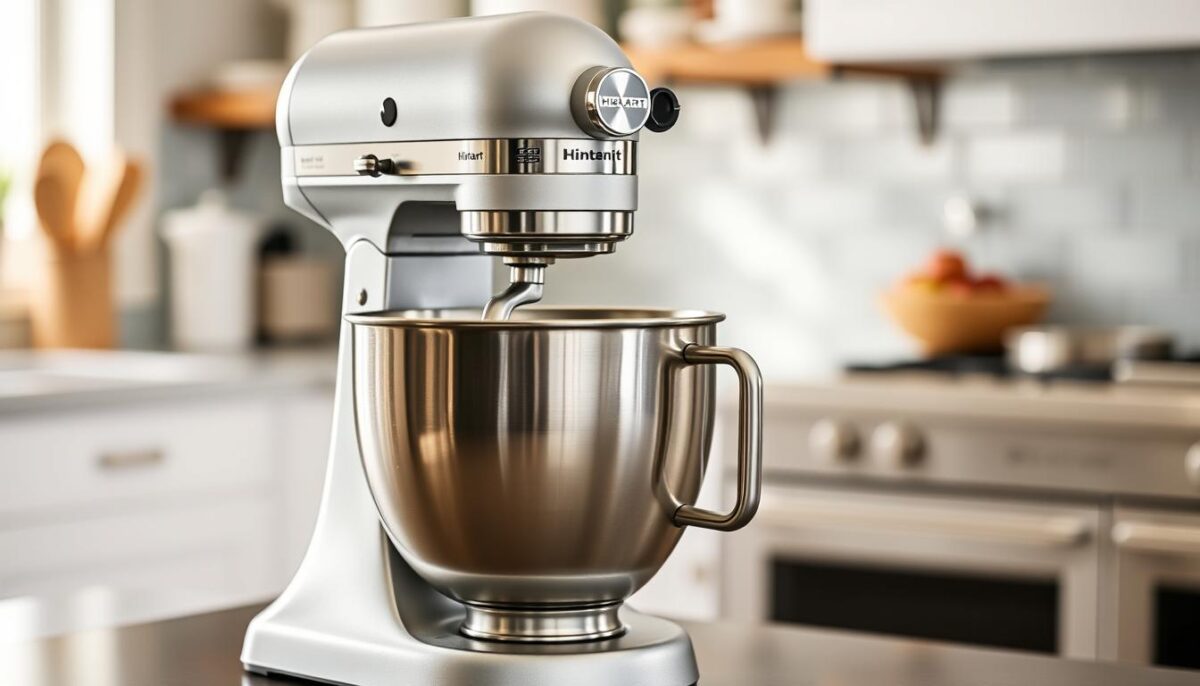
The Hobart Legacy+ series stands out for its advanced features and robust construction. The HL200 model, for instance, boasts a 0.5hp motor, a 20-quart bowl, and a variable-frequency drive that ensures precise control over mixing operations. It also features three fixed speeds, a stir speed with soft-start agitation, and shift-on-the-fly control. The 15-minute smart timer and automatic time recall add to its convenience and efficiency.
Globe SP Series
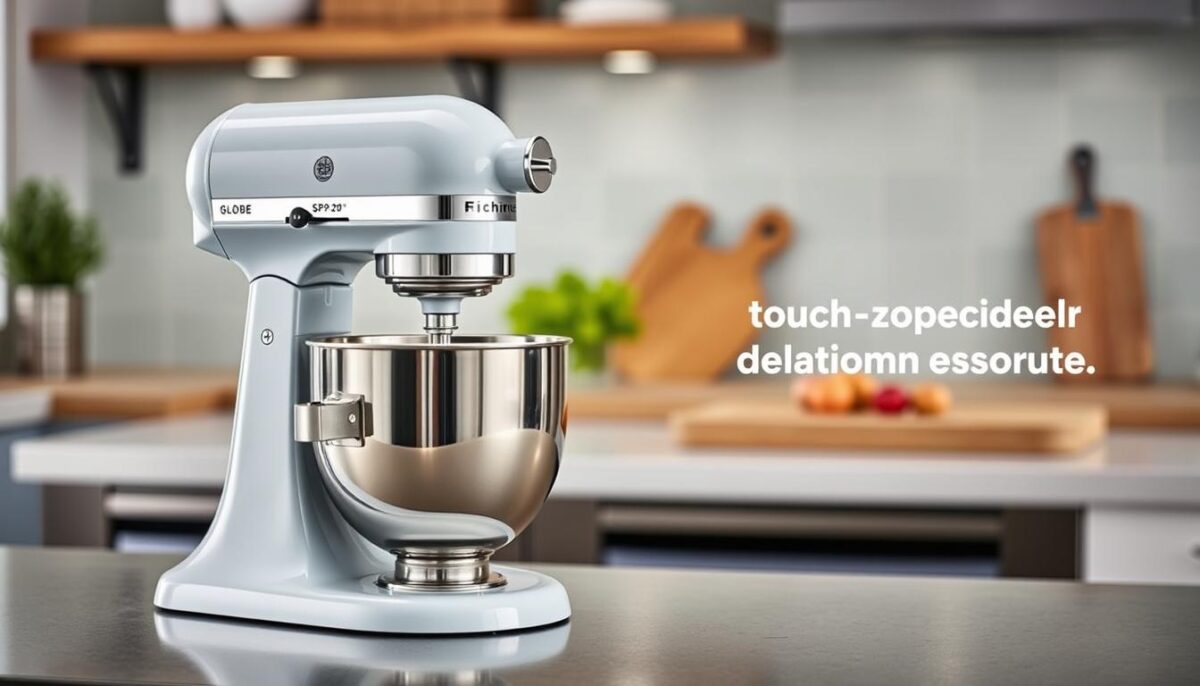
Globe’s SP series mixers are designed for high-torque performance and durability. The SP20 model, with its 0.5 hp motor and 20-quart capacity, is ideal for kitchens requiring more power and capacity. It features three fixed speeds, a permanently lubricated transmission, and a rigid cast-iron body. The front-mounted touch controls, 60-minute digital timer, and last-batch recall feature make it user-friendly and efficient.
Best Value Options from Both Brands
When comparing similar models from Hobart and Globe, such as the HL200 and SP20, several factors come into play, including specifications, features, and performance. Both models offer unique benefits, with the Hobart HL200 providing advanced timer functions and the Globe SP20 offering a robust, gear-driven design. The best value options will depend on the specific needs of the operation, including the type of food preparation, kitchen size, and budget.
Ultimately, the choice between Hobart and Globe commercial mixers will depend on evaluating the features, performance, and price of their various models. By considering the Legacy+ and SP series, among others, businesses can find the optimal mixer for their needs.
Conclusion: Making Your Final Decision
In the end, selecting the ideal mixer depends on understanding your specific kitchen needs and how they align with the strengths of Hobart or Globe mixers.
To make an informed decision, consider factors like mixer size, power, versatility, and total cost of ownership. Both Hobart and Globe offer quality commercial mixers, but they excel in different areas that may be more or less important to your operation.
Key considerations include your specific application, volume requirements, budget constraints, and long-term business plans. I recommend consulting with equipment specialists who can provide personalized guidance based on your kitchen requirements.
Investing time in selecting the right mixer will pay dividends through improved efficiency, consistency, and equipment longevity. Ultimately, choose a commercial mixer that will grow with your business and provide reliable service for years to come.
FAQ
What factors should I consider when choosing a commercial mixing equipment for my kitchen?
When selecting a commercial mixer, consider the type of food you’ll be preparing, the volume of your operations, available kitchen space, and your budget. Think about the motor power, bowl capacity, and attachments you’ll need to efficiently mix ingredients.
How do I determine the right speed and agitator for my mixing needs?
The right speed and agitator depend on the specific task. For example, a planetary mixer is versatile and suitable for a variety of mixing tasks, while a spiral mixer is ideal for dough. Consider the types of ingredients you’ll be mixing and the desired outcome.
What is the importance of maintenance for my commercial mixer?
Regular maintenance is crucial to extend the lifespan of your mixer, ensure optimal performance, and prevent costly repairs. Check and replace worn-out parts, clean the mixer regularly, and follow the manufacturer’s maintenance guidelines.
Can I use a commercial mixer for pizza dough and other heavy mixing tasks?
Yes, many commercial mixers are designed to handle heavy mixing tasks like dough for pizza, bread, and pastries. Look for mixers with robust motors and suitable attachments to handle these tasks efficiently.
How do I assess the total cost of ownership for a commercial mixer?
To calculate the total cost of ownership, consider the purchase price, ongoing maintenance costs, energy consumption, and any additional expenses for attachments or repairs. A mixer with a higher upfront cost may be more cost-effective in the long run if it’s more durable and requires less maintenance.
What are the benefits of investing in a high-quality commercial mixer from a reputable brand?
A high-quality commercial mixer from a reputable brand can provide reliable performance, durability, and versatility. It can also offer better control options, precision, and capacity, making it a valuable investment for your kitchen’s efficiency and productivity.
